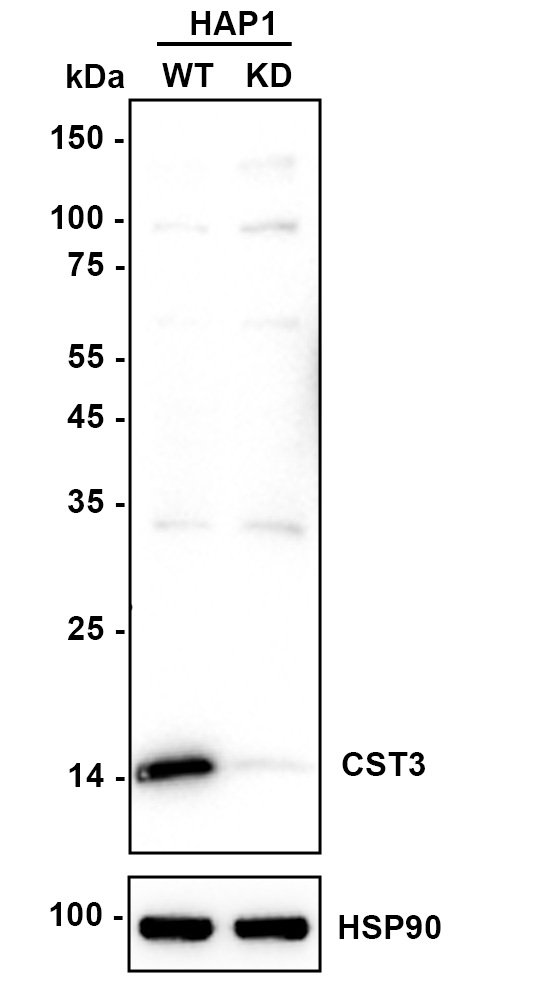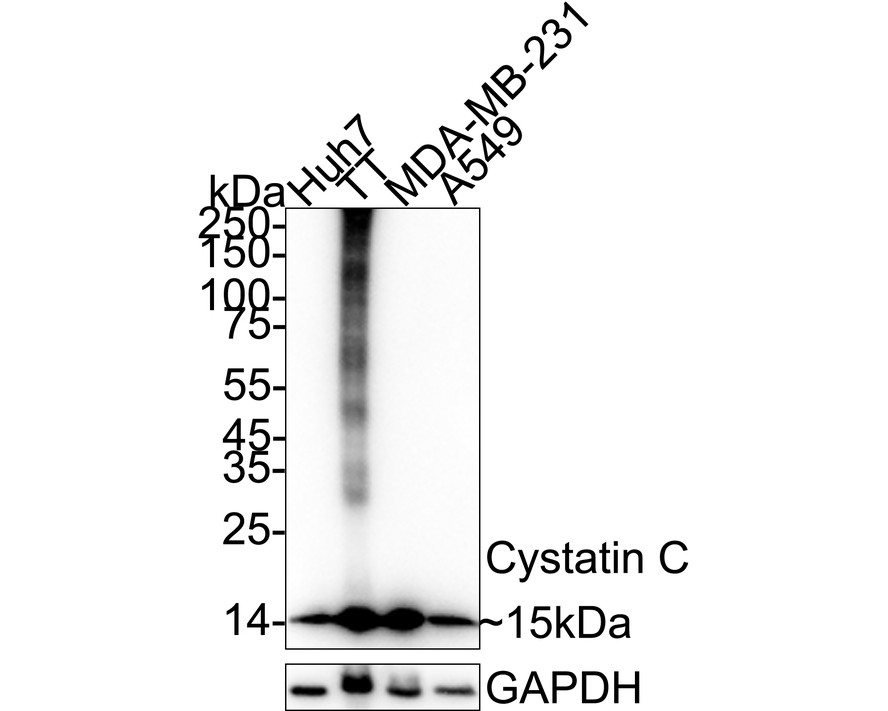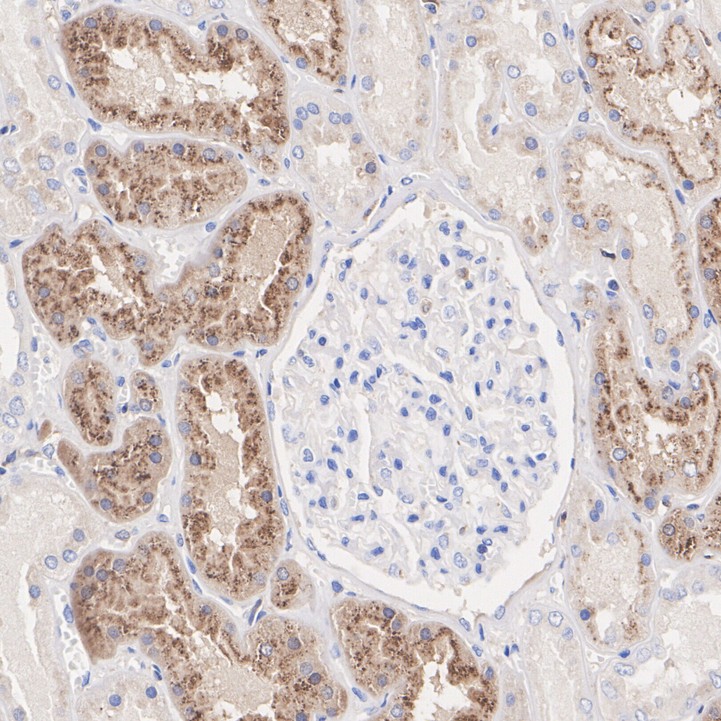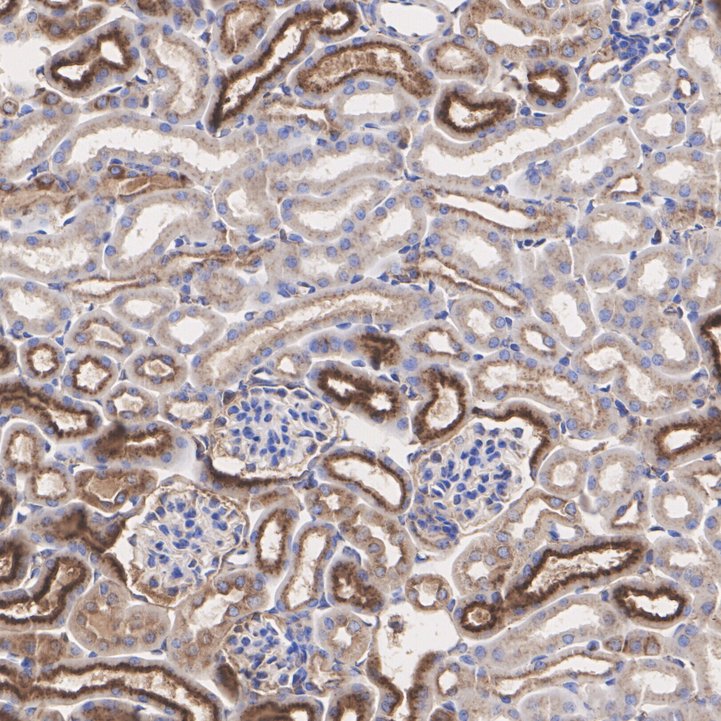Cystatin C Recombinant Rabbit Monoclonal Antibody [JJ09-16]

cat.: ET1701-72
| Product Type: | Recombinant Rabbit monoclonal IgG, primary antibodies |
|---|---|
| Species reactivity: | Human, Mouse, Rat |
| Applications: | WB, IHC-P |
| Clonality: | Monoclonal |
| Clone number: | JJ09-16 |
| Form: | Liquid |
| Storage condition: | Shipped at 4℃. Store at +4℃ short term (1-2 weeks). It is recommended to aliquot into single-use upon delivery. Store at -20℃ long term. |
| Storage buffer: | 1*TBS (pH7.4), 0.05% BSA, 40% Glycerol. Preservative: 0.05% Sodium Azide. |
| Concentration: | 1ug/ul |
| Purification: | Protein A affinity purified. |
| Molecular weight: | Predicted band size: 16 kDa |
| Isotype: | IgG |
| Immunogen: | Recombinant full length protein of Human Cystatin C aa 1-146 / 146. |
| Positive control: | HAP1-parental cell lysate, HAP1-商品名 KD cell lysate, Huh7 cell lysate, TT cell lysate, MDA-MB-231 cell lysate, A549 cell lysate, human kidney tissue, mouse kidney tissue, rat kidney tissue. |
| Subcellular location: | Secreted. |
| Recommended Dilutions:
WB IHC-P |
1:2,000 1:200-1:1,000 |
| Uniprot #: | SwissProt: P01034 Human | P21460 Mouse | P14841 Rat |
| Alternative names: | AD 8 AD8 Amyloid angiopathy and cerebral hemorrhage ARMD11 bA218C14.4 (cystatin C) bA218C14.4 Cst 3 Cst3 CST3 protein Cystatin 3 Cystatin-3 Cystatin-C Cystatin3 CystatinC CYTC_HUMAN Epididymis secretory protein Li 2 Gamma trace Gamma-trace HCCAA HEL S 2 MGC117328 Neuroendocrine basic polypeptide Post gamma globulin Post-gamma-globulin |
Images

|
Fig1:
Western blot analysis of Cystatin C on different lysates with Rabbit anti-Cystatin C antibody (ET1701-72) at 1/1,000 dilution. Lane 1: HAP1-parental cell lysate Lane 2: HAP1-Cystatin C KD cell lysate Lysates/proteins at 10 µg/Lane. Predicted band size: 16 kDa Observed band size: 15 kDa Exposure time: 120 seconds; ECL: K1801; 4-20% SDS-PAGE gel. Proteins were transferred to a PVDF membrane and blocked with 5% NFDM/TBST for 1 hour at room temperature. The primary antibody (ET1701-72) at 1/1,000 dilution was used in K1803 at 4℃ overnight. Goat Anti-Rabbit IgG - HRP Secondary Antibody (HA1001) at 1/50,000 dilution was used for 1 hour at room temperature. |

|
Fig2:
Western blot analysis of Cystatin C on different lysates with Rabbit anti-Cystatin C antibody (ET1701-72) at 1/2,000 dilution. Lane 1: Huh7 cell lysate Lane 2: TT cell lysate Lane 3: MDA-MB-231 cell lysate Lane 4: A549 cell lysate Lysates/proteins at 20 µg/Lane. Predicted band size: 16 kDa Observed band size: 15 kDa Exposure time: 1 minute; ECL: K1801; 4-20% SDS-PAGE gel. Proteins were transferred to a PVDF membrane and blocked with 5% NFDM/TBST for 1 hour at room temperature. The primary antibody (ET1701-72) at 1/2,000 dilution was used in 5% NFDM/TBST at 4℃ overnight. Goat Anti-Rabbit IgG - HRP Secondary Antibody (HA1001) at 1/50,000 dilution was used for 1 hour at room temperature. |

|
Fig3:
Immunohistochemical analysis of paraffin-embedded human kidney tissue with Rabbit anti-Cystatin C antibody (ET1701-72) at 1/1,000 dilution. The section was pre-treated using heat mediated antigen retrieval with Tris-EDTA buffer (pH 9.0) for 20 minutes. The tissues were blocked in 1% BSA for 20 minutes at room temperature, washed with ddH2O and PBS, and then probed with the primary antibody (ET1701-72) at 1/1,000 dilution for 1 hour at room temperature. The detection was performed using an HRP conjugated compact polymer system. DAB was used as the chromogen. Tissues were counterstained with hematoxylin and mounted with DPX. |

|
Fig4:
Immunohistochemical analysis of paraffin-embedded mouse kidney tissue with Rabbit anti-Cystatin C antibody (ET1701-72) at 1/200 dilution. The section was pre-treated using heat mediated antigen retrieval with Tris-EDTA buffer (pH 9.0) for 20 minutes. The tissues were blocked in 1% BSA for 20 minutes at room temperature, washed with ddH2O and PBS, and then probed with the primary antibody (ET1701-72) at 1/200 dilution for 1 hour at room temperature. The detection was performed using an HRP conjugated compact polymer system. DAB was used as the chromogen. Tissues were counterstained with hematoxylin and mounted with DPX. |

|
Fig5:
Immunohistochemical analysis of paraffin-embedded rat kidney tissue with Rabbit anti-Cystatin C antibody (ET1701-72) at 1/200 dilution. The section was pre-treated using heat mediated antigen retrieval with Tris-EDTA buffer (pH 9.0) for 20 minutes. The tissues were blocked in 1% BSA for 20 minutes at room temperature, washed with ddH2O and PBS, and then probed with the primary antibody (ET1701-72) at 1/200 dilution for 1 hour at room temperature. The detection was performed using an HRP conjugated compact polymer system. DAB was used as the chromogen. Tissues were counterstained with hematoxylin and mounted with DPX. |
Note: All products are “FOR RESEARCH USE ONLY AND ARE NOT INTENDED FOR DIAGNOSTIC OR THERAPEUTIC USE”.